A rich historical site, Hampi is also touted as the world’s largest open-air museum, with a treasure trove of temples.
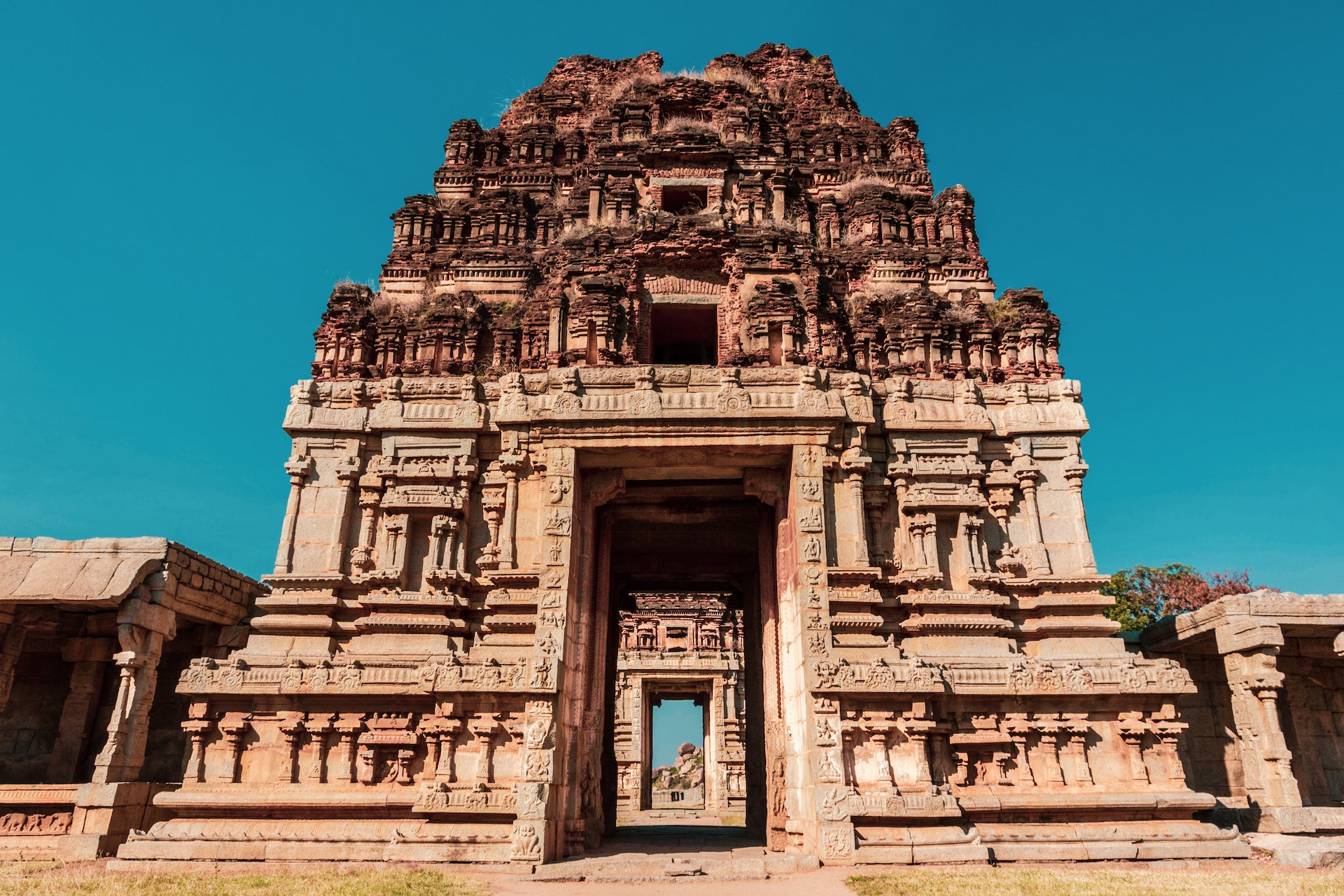
Hampi is a treasure trove of history, full of stories of the changes it witnessed and endured through the ages. (Creative Commons)
A trip to Hampi is a pre-requisite for anyone nurturing an ardent love for Indian history and architectural marvels from another time.
This rich historical site, which is touted as the world’s largest open-air museum, is a treasure trove of temples, sculptures and endless ruins, dripping with stories of the many changes it witnessed and endured through the ages.
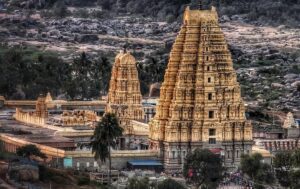
The Sri Virupaksha Temple is one of the oldest and most exquisite temples to visit in Hampi. (Creative Commons)
From once being part of the glorious Vijayanagara Empire to being reduced to ruins and rubble following the invasion by the Deccan Sultanates, Hampi is an open book of splendid stories just waiting to be read and seen by people, especially history buffs.
Planning a trip to Hampi requires a bit of research as you need to know about the places to visit, given the site can take over two days to be explored in its entirety.
Naturally, one must try and cover as many locations as you can when visiting; however, the following are the 5 spots at the historical site one must absolutely visit, especially if you are visiting for the first time:
Dedicated to Lord Shiva, the Sri Virupaksha Temple is easily one of the oldest and most exquisite places to visit in Hampi. Built in the 7th century, the Hindu temple is still functional and is one of the oldest living temples in India.
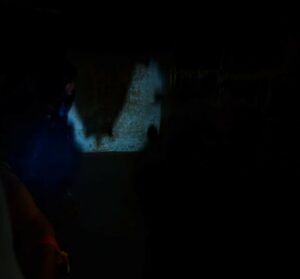
The shadow of the highest gopuram is visible in an inverted form through a tiny hole. (Prasanna RS/South First)
“Hiring a tour guide was the best decision I made on the trip because the stories and details he told us were simply mindblowing. The stone that this temple is made of is so beautiful that it appeared to be changing colours on its own throughout the day,” Sumit Madhavan, a 25-year-old engineer from Kerala who visited the site last month, tells South First.
“A fascinating detail the guide showed us was a sort of inverted shadow that was created on the temple wall, where the shadow of the highest gopuram was visible in an inverted form, through a little hole. The intentional purpose of this design makes one wonder about the amazing brilliance of the craftsmen from those days. You just have to see this for yourself,” Madhavan adds.
He shared another amazing feature to check out — the underwater Shiva Temple, where the inner sections of the shrine are always filled with water. However, tourists can only visit inside during the summer months, as people are not allowed in during the monsoon months from August to October as the water level is high at the time.
The inner sanctum remains submerged throughout the year.
One of the most famous temples and places to visit in Hampi is the Vijaya Vittala Temple. An architectural masterpiece, it is one of the largest historical structures in Hampi, dedicated to Lord Vishnu’s incarnation, Lord Vittala.
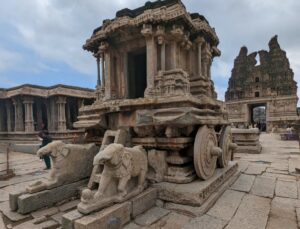
The Stone Chariot is an iconic monument located in front of the Vijaya Vittala Temple. (Prasanna RS/South First)
At the premises of the temple, you will find unparalleled craftsmanship of the Vijayanagara Empire in the form of the iconic stone chariot, sculptures with intricate designs, the legendary musical pillars and peaceful temple halls. These are some of the many features that you just can’t miss.
“The best decision I made was to come here in the early hours as the absolute lack of people elevated the beauty of the place and I felt like I was walking in a world from another time altogether,” Madhavan says.
“The endless carvings at the bottom part of the Maha Mantapa which, according to the guide, depict life from 500 years ago, was unbelievable. You can see traders doing their business and people going on with their lives in the carvings. But what left me stunned were the depictions of traders from Europe and other parts of the world, clearly indicating how the magnificent Vijayanagara Empire was flourishing in trade with the rest of the world,” he adds.
The Vittala Temple lies partially ruined, as the central western hall of the temple was ruined long ago during the invasion by the Deccan Sultanates that led to the downfall of the Vijayanagara Empire in 1565 CE.
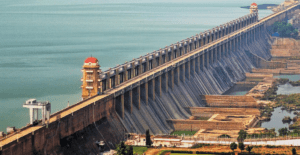
The Tungabhadra gardens and dam is one of the most famous places to visit in Hampi and is central to the town. (Creative Commons)
Located about 5 km from Hospet, the Tungabhadra gardens and dam are worth a visit in Hampi. Besides being an absolute visual feast, the dam is central to Hampi as it caters to almost every crucial function, including electricity generation and irrigation.
“It’s a good thing I came alone here because the amount of walking I did, my old parents would never be able to keep up. I managed to walk all the top of the way to the dam and the view was unbelievable. Felt like I was in a movie! I came to the location at the end of my trip after visiting the ruins and it was the perfect spot for me to unwind, relax and absorb all the historic richness I has witnessed earlier at the architectural marvels of Hampi,” Vineesha Podwal from Maharashtra who made a solo trip to the location tells South First.
Touted to be one of the most imposing sculptures in Hampi, the Lakshmi Narasimha statue is the largest monolith statue in the archaeological site. The Lakshmi Narasimha Temple, also called Ugra Narasimha (i.e. Narasimha in its terrifying form) houses the brilliant and striking statue of Lord Narasimha, who is the reincarnation of Lord Vishnu, and portrayed as a half lion and half human sitting in a cross-legged position with a fierce expression.
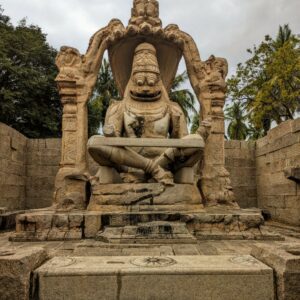
Lord Narasimha is portrayed as a half lion and half human sitting in a cross-legged position with a fierce expression. (Prasanna RS/South First)
Built in 1528 CE and standing about 6.7 meters tall, the original sculpture also had a small figure of Goddess Lakshmi sitting on Narasimha’s lap, however, the statue was vandalised during the invasion by the Deccan Sultanates in 1565 CE. This is definitely among the top places to visit in Hampi.
“My camera almost ran out of battery as I ended up taking countless pictures of the temple complex. The terrifying statue of the Narasimha staring right into my soul with his bulging eyes is a sight I will never forget. What I really can’t believe is that such a huge sculpture was made from a single granite boulder. Clearly, the craftsmen from that era were already way ahead of their time,” Podwal says.
Offering a one-of-a-kind experience, the Riverside ruins can end up surprising many tourists who probably won’t expect to see statues and ancient architectural structures scattered on the banks of the Tungabhadra river.
“On the second day of my trip, I overheard about the over a thousand linga statues lying in a cluster on the riverside gorge just north of the Kodandarama Temple, and I knew I just had to see it for myself. I was taken completely by surprise because I had never read about this, nor did I hear tourists discuss this place while mentioning their travels to Hampi,” recalls Madhavan.
“As I explored the area close to the edge of the river, I saw the many Lingas carved onto a flat rock surface. And a bit further on another rock surface, I saw the carved sculpture of Lord Vishnu in a reclined position. Saying that my mind was blown is an understatement,” he adds about what he discovered as he explored the Riverside Ruins.
This location is rather isolated compared to the other attractions in Hampi, ergo the area appears to be practically empty of the throng of tourists at times.
A few metres from the riverside, one can then proceed to the narrowest portions of the river. And given the slippery rock surfaces which are close to the torrents, tourists are cautioned by the guides to never venture into the waters, whatsoever.
“Since the river was not turbulent at the time, I reached the location on a hired coracle ride and got a much closer look at the Shiva Linga site. It was so calm and serene. This was the perfect ending to my trip,” Madhavan adds.
How to reach Hampi
Air: Ballari (Bellary) is the closest town to Hampi to have an airport. You can reach Ballari by local transportation.
Rail: The nearest railway station can be found in Hosapete (Hospet), which is situated around 10 km from Hampi.
Road: Locals suggest boarding a bus from Hosapete to Hampi, calling it the easiest way. Also, tourists can travel by car if they are arriving from Mysuru or Bengaluru.
The best time to visit Hampi is between November and February — and keep in mind, December and January are the peak traffic months. Tourists should try and avoid summers to visit as it gets exceptionally hot and there is a lot of walking to do, so it’s not ideal.

Apr 27, 2024

Apr 27, 2024

Apr 26, 2024

Apr 26, 2024

Apr 26, 2024

Apr 26, 2024